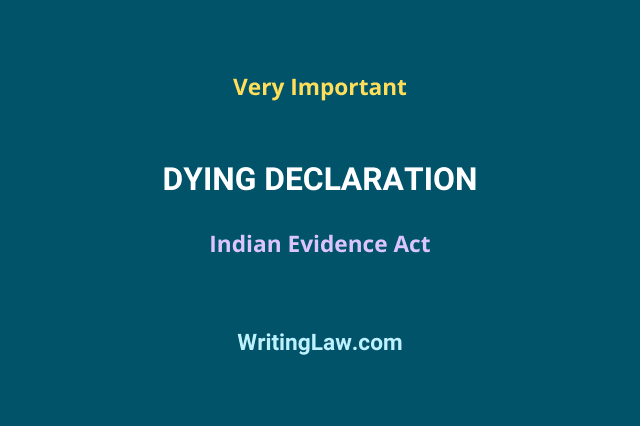
Section 32 of the Indian Evidence Act deals with statement of relevant fact, which may be either in written form or said verbally by a person:
- who is dead.
- who cannot be found.
- who is incapable of giving evidence.
- whose attendance cannot be procured without an amount of delay or expense which under the circumstance appears unreasonable to the court.
In this article, we have discussed the statement of a person who is dead.
Dying Declaration Meaning
In Sudhakar and Anr vs the State of Maharashtra, dying declaration was defined as follows:
Sub-section (1) of section 32 of the Evidence Act provides that when the statement is made by a person as to the cause of his death or as to any circumstances of the transaction which resulted in his death, being relevant fact, is admissible in evidence. Such statements are commonly known as dying declaration.
In Ram Bihari Yadav vs the State of Bihar (1998), Justice Syed Quadri explained the dying declaration as:
A dying declaration made by a person who is dead as to the cause of his death or as to any of the circumstances of the transaction which resulted in his death. In cases in which the cause of his death comes into question is relevant under section 32 of the Indian Evidence Act and is also admissible in evidence.
It is to be noted that the dying declaration is indirect evidence, so it is an exception to the rule against the admissibility of hearsay evidence.
Related: What Is Hearsay Evidence Under Evidence Act
Elements of Dying Declaration
The elements of dying declaration are illustrated under section 32(1) of the Indian Evidence Act. According to section 32(1) of the Indian Evidence Act, dying declaration is a statement:
- Written or verbal,
- Of relevant facts,
- Made by a person who is dead.
Such statement is relevant when the statement is made by the person as to:
- The cause of his death.
- Any circumstance of the transaction that resulted in his death.
Such statements are relevant:
- Whether the person who made them was or was not at the time when they were made under the expectation of death.
- Whatever may be the nature of the proceeding in which the cause of death comes into question.
Dying Declaration Under English Law
In English law, dying declaration is relevant, but two conditions are required:
(i) the person must be in expectation of death.
(ii) the nature of the proceeding must be criminal, and the accused is charged with murder or culpable homicide.
Related: What Is Culpable Homicide as Per Section 299 of IPC
Pakala Narayan Swami vs Emperor (1939) (Privy Council)
Facts of the case:
- The deceased received a letter from the accused’s wife on 20 March inviting him to her house.
- The deceased left his house on 21 March, informing his wife about the letter.
- On 23 March, the deceased was found dead in a trunk cut into seven portions.
- The body was identified and the accused was tried and convicted for murder.
The wife’s statement was admissible under section 32(1) of the Indian Evidence Act, 1872. The statement may be made before the cause of death had arisen or before the deceased had any reason to anticipate being killed.
In Kans Raj vs the State of Punjab, it was held that the statement of the deceased relating to the cause of his death or circumstances of transaction that led to his death must be sufficiently and clearly related to the actual transaction.
Read: Full Indian Evidence Act
Evidentiary Value of Dying Declaration
The dying declaration is admitted on the principle of “Nemo moriturns proesumitur mentiri” which means a man will not meet his maker with a lie in his mouth.
A dying declaration is substantive evidence and can be the sole ground of judgement. The probative force of the dying declaration depends on the facts and circumstances of each case. If the court finds it is true and voluntary, further corroboration may not be required. But when required and necessary, it may be corroborated with other independent evidence.
You May Like: Evidentiary Value of Accomplice Evidence
To Whom Dying Declaration be Made?
Section 32(1) of the Indian Evidence Act doesn’t specify as to whom the dying declaration can be made. A dying declaration can be made to anyone. It may be a friend, relative and even stranger. It is to be noted that a dying declaration made to a magistrate will have high probative force as compared to a dying declaration made to a stranger.
Dying Declaration by Signs
In Queen Empress vs Abdullah, the woman’s throat was slit, due to which she was unable to speak. She suggested the name of the accused by sign. It was held that questions and signs taken together might be regarded as a verbal statement made by a person as to the cause of his death within the meaning of section 32 of the Indian Evidence Act, 1872.
FIR as Dying Declaration
In Mahmood Illahi vs State of Uttar Pradesh (1990), the court held that a report made by the deceased regarding the cause of his death or the circumstances that caused his death to the police officer shall be relevant under section 32(1) of the Indian Evidence Act, 1872.
Related: FIR and Charge Sheet – Section 154 and Section 173 CrPC
Read Next: Recent and Landmark Case Laws for Dying Declaration
- What Is a Foreign Judgement and When It’s Not Binding in India - 26th July 2022
- What Are Second Appeals Under Civil Law - 23rd June 2022
- Civil Appeal as Per the Civil Procedure Code - 12th June 2022







